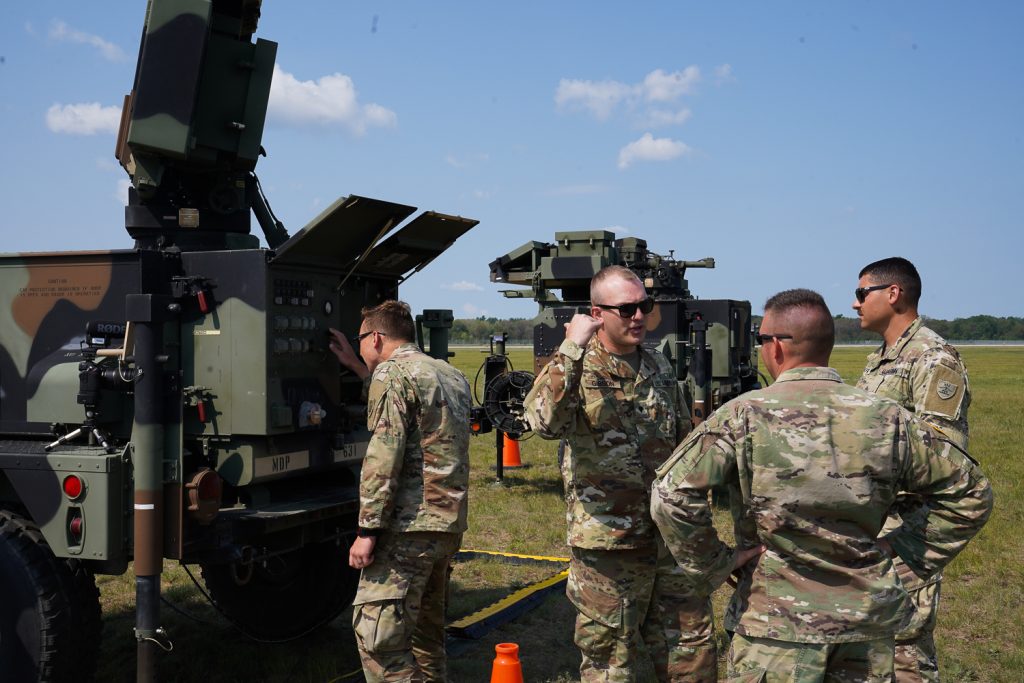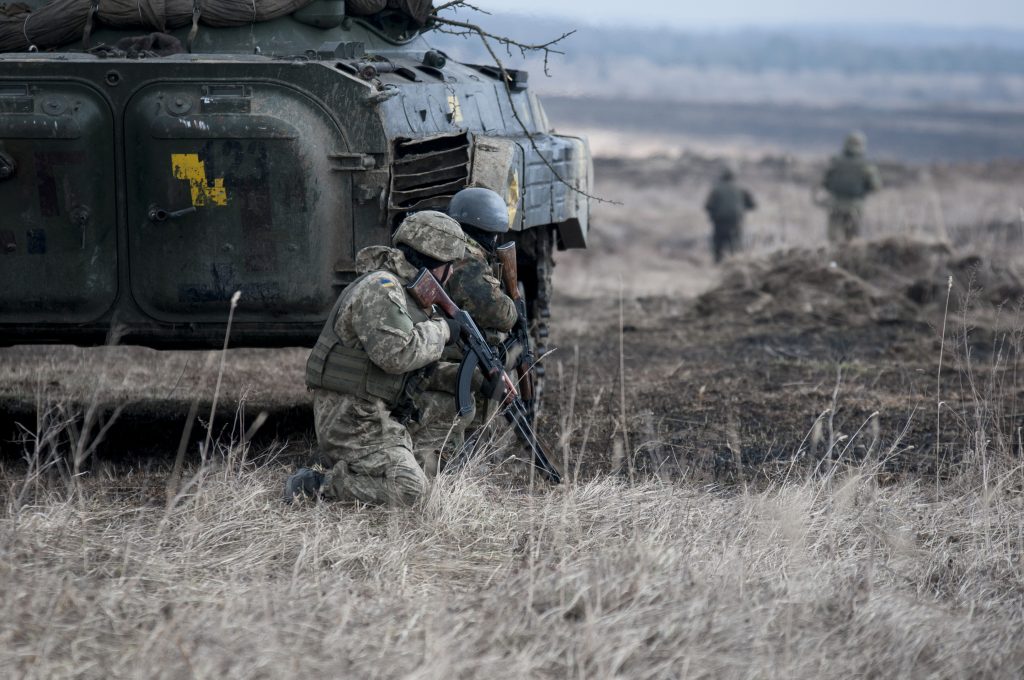
LIVE-FIRE EXERCISE: A Soldier from the 45th Infantry Brigade Combat Team, Oklahoma Army National Guard radios his unit notifying them the heavy machine guns manned by soldiers of the Ukranian army’s 28th Mechanized Infantry Brigade have finished firing so their fellow Ukranian soldiers can advance on an objective during a live-fire training exercise at the Yavoriv Combat Training Center on the International Peacekeeping and Security Center, near Yavoriv, Ukraine, in 2017. (Photo by Sgt. Anthony Jones, 45th Infantry Brigade Combat Team)
How the National Advanced Surface to Air Missile System was procured for Ukraine in record time.
by Mark Talbot and Bill Trainer
When Russia invaded Ukraine on Feb. 24, 2022, many predicted a swift collapse in a “David versus Goliath” scenario. The Russian military wrought death and destruction on a scale not seen since World War II. Conflict in and around urban areas created a humanitarian crisis with millions of displaced refugees and thousands of civilian casualties. The U.S. government, along with many of our allied partners, immediately laid out plans to provide resources to Ukraine to defend against Russian aggression.
For Ukraine, the secretary of state has exercised authority delegated by the president to direct 37 drawdowns totaling approximately $21.1 billion in defense articles and services from the Department of Defense since August 2021, in response to Russia’s preparation to launch the full-scale invasion of Ukraine and continued war. As the proponent for many of the relevant weapon systems, the Program Executive Office for Missiles and Space (PEO MS) on Redstone Arsenal in Alabama has played a key role. PEO MS was tasked with delivering more than 10,000 Javelin anti-armor systems, 1,700 Stinger anti-aircraft systems and 4,000 Tube-Launched, Optically Tracked, Wire-Guided missiles. The Army quickly delivered the first shipment of 200 Stinger missiles to Ukraine after hostilities began. Several North Atlantic Treaty Organization (NATO) partner countries also contributed war materiel to the resistance. The aforementioned assistance, combined with Ukrainian bravery and tenacity on the battlefield, have altered the strategic landscape.
THE NASAMS SOLUTION
While the ground assault largely stalled, the Russian military continued to terrorize cities with cruise missiles, rockets and unmanned aircraft systems. The Ukrainians did not possess sufficient capability to defeat these threats, thus posing an enduring vulnerability for which they turned to the international community for a solution. The National Advanced Surface to Air Missile System (NASAMS), currently an integral component of the North American Aerospace Defense Command protecting the U.S. National Capitol Region, was well-suited for this requirement. This system consists of the Norwegian Fire Distribution Center and launchers, U.S. government Sentinel radar and the Advanced Medium-Range Air-to-Air Missile.
Congress responded to this urgent need and earmarked funds to procure two NASAMS firing units on behalf of Ukraine late in fiscal year 2022 under the Ukrainian Security Assistance Initiative. The U.S. Army immediately initiated a Building Partner Capacity foreign military sales case for NASAMS for the first two firing units, and the U.S. government has since supplemented the initial requirement with an additional six firing units. The fact that NASAMS is a nonstandard, non-program of record capability consisting of both U.S. and Norwegian components presented a procurement challenge. Nevertheless, the mission demanded progress at the speed of need.
The Army assigned this opportunity to PEO MS on July 28, 2022, with the expectation to deliver a comprehensive approach consisting of hardware, software, training and logistical support in a matter of weeks to support wartime requirements. Following standard acquisition timelines, however, would result in an approximately four-year wait for Ukraine to receive this capability: two years to award a contract plus an additional two years for the defense industry to fabricate and integrate the necessary equipment. Given the urgency, PEO MS could not settle for the status quo.
Project Manager for Short and Intermediate Effectors for Layered Defense, or SHIELD, and the Search, Track, Acquire, Radiate and Eliminate, or STARE program within PEO MS immediately formed an integrated product team to address the requirement. The team included representatives from the Security Assistance Management Directorate, the assistant PEO for international affairs, industry partners, the U.S. Air Force and U.S. Navy, and the U.S. Army Contracting Command ‒ Redstone to collaborate and forge a way ahead. The industry partners committed to maximize the use of on-hand vendor assets to deliver launchers and fire distribution centers. The Army secured equipment from existing stocks and provided an ancillary enabling kit as government furnished equipment to round out the materiel package. This approach shaved two years off the timeline by eliminating the production of new hardware. However, the challenge of quickly awarding a procurement mechanism remained.

SENTINEL DRILLS: Sentinel radar operators with the 188th Air Defense Artillery Regiment, North Dakota Army National Guard participate in the Global Information Dominance Experiment 3 and Architecture and Demonstration Evaluation 5 at Camp Grayling, Michigan, in 2021. The Sentinel radar is a component of the National Advanced Surface to Air Missile System. (Photo by Tech. Sgt. Amy Picard, U.S. Air Force)
RAPID NEW REQUIREMENTS PACKAGE
Delivering NASAMS and the associated services for Ukraine required an entirely new contract award. The NASAMS integrated product team met daily to discuss and draft the contracts requirements package and all supporting documents. The U.S. government reached an agreement on the statement of work with industry partners in a matter of days. The combined government and industry team moved quickly within a contracting framework usually characterized as bureaucratic and glacial.
The integrated product team accomplished tasks in a few days that usually require months of painstaking deliberations. In addition to a keen focus at the execution level, stakeholder alignment among senior leaders proved essential to awarding a contract in a timely manner. The entire chain of command from top to bottom within Army Contracting Command – Redstone, PEO MS, the Assistant Secretary of the Army for Acquisition, Logistics and Technology, and the U.S. Army Security Assistance Command made this effort a top priority. All requirements were hand-carried and briefed in real time; nothing languished in a leader’s inbox. Once the requirement was received from PEO MS in July, the collective team worked relentlessly to award a NASAMS contract on Aug. 26—less than a month from receipt of the requirement.
This accomplishment, however, is by no means the end of the effort. Although the Not-To-Exceed Undefinitized Contractual Actions provided a mechanism to initiate industry support as quickly as possible, the team continues to coordinate all support requirements, refine the scope of work, and finalize the contract to authorize full funding and continue support to Ukraine. Meanwhile, the same team attends to a comprehensive set of logistical details including organizing overseas training, coordinating U.S. government receipt and acceptance of hardware, transportation and logistics for our Ukrainian partners, interpreters and creating a forward-based maintenance concept.
In order to accomplish these diverse tasks, the set of stakeholders rapidly grew to include the European Command headquarters, U.S. Department of State and Offices of Defense Cooperation in multiple countries, NATO headquarters, allied military services and the U.S. Air Force Mobility Command. The U.S. government delivered Ukraine a total package approach to ensure an enduring and effective combat capability.
Rapidly delivering a nonstandard, non-program of record capability composed largely of foreign materiel to Ukraine without the benefit of either an existing contract or teaming agreement posed a complex challenge. This problem set demanded innovation and diligence combined with technical, programmatic and security assistance expertise. In addition to these competencies, keeping all senior leaders engaged and supportive of the effort with concise and consistent messaging proved the crucial factor to deliver NASAMS to Ukraine.

TAKING COVER: Ukrainian soldiers of the 1st Battalion, 28th Mechanized Infantry Brigade take cover behind their BMP-2 armored vehicle while other soldiers rush ahead to breach a wire obstacle blocking their unit’s advance during training at the Yavoriv Combat Training Center at the International Peacekeeping and Security Center, near Yavoriv, Ukraine, in 2017. (Photo by Sgt. Anthony Jones, 45th Infantry Brigade)
CONCLUSION
The PEO MS team is now leveraging the lessons learned from delivering the first two firing units of NASAMS capability to form an acquisition approach for future requirements for other partner nations expressing interest. The integrated product team is working to finalize additional NASAMS contracts associated with new foreign military sales cases while concurrently finalizing and executing the details associated with the next six firing units for Ukraine. The realm of the possible expands significantly with teamwork, expertise and committed leadership focused on delivering capability to the warfighter at the speed of need.
For more information contact Bill Trainer, division chief, international programs, Lower Tier Interceptors & Launchers & NASAMS, at 256-842-0705 or william.j.trainer.civ@army.mil.
MARK TALBOT is a systems engineering and technical assistance contractor at PEO MS. He retired from the Army in 2016 after a diverse enlisted and commissioned career totaling nearly 30 years. He holds an M.S. in environmental engineering from the University of North Carolina at Chapel Hill, and a B.S. in environmental engineering from the United States Military Academy at West Point.
BILL TRAINER is an international program manager at PEO MS. His assignments included three tours in Germany and numerous stateside positions, as well as a deployment with the 24th Infantry Division in support of Operation Desert Storm. Following retirement from active duty, he spent 10 years as a defense support contractor before returning to government service as an Army civilian. He holds a B.S. in business from Columbia College.







